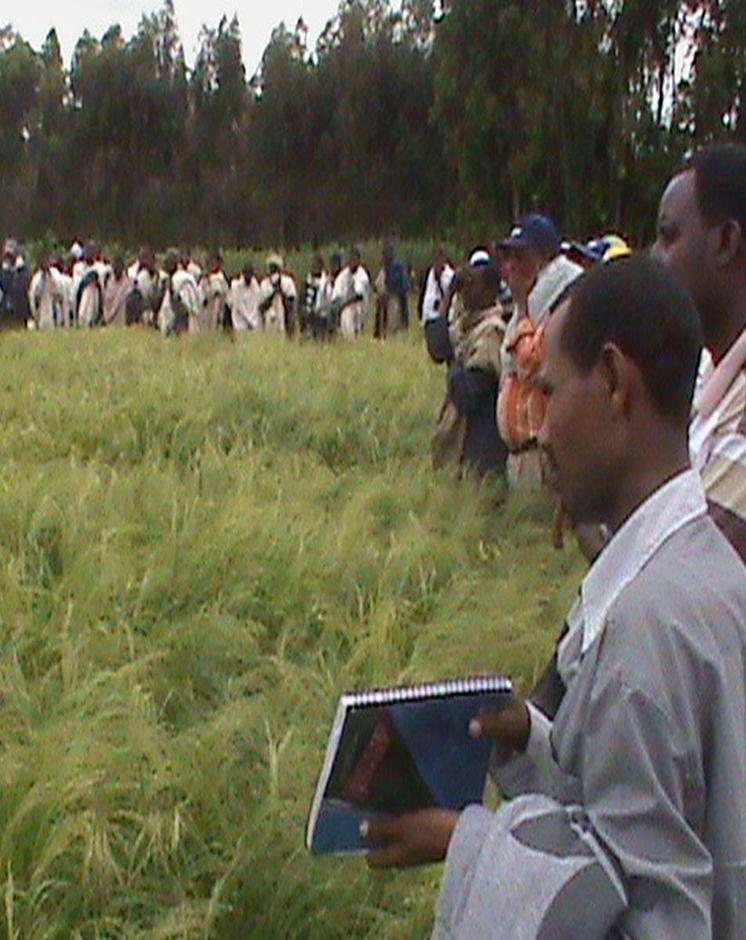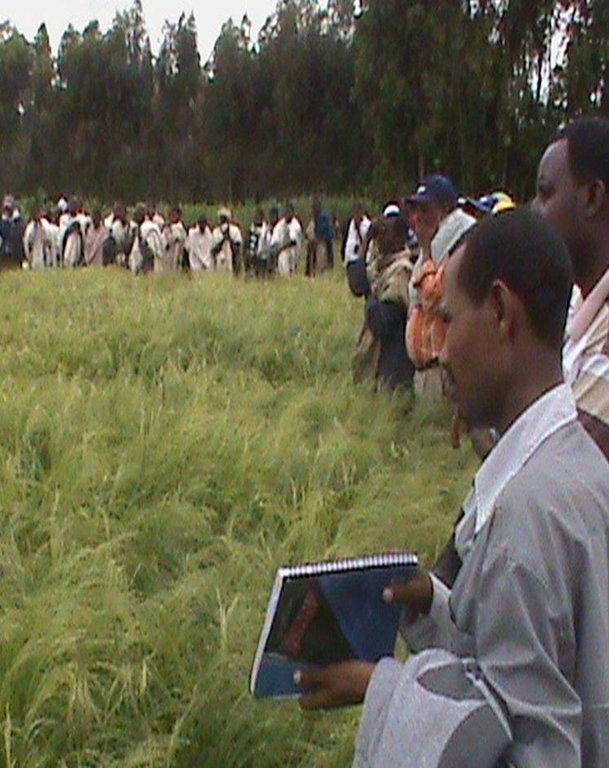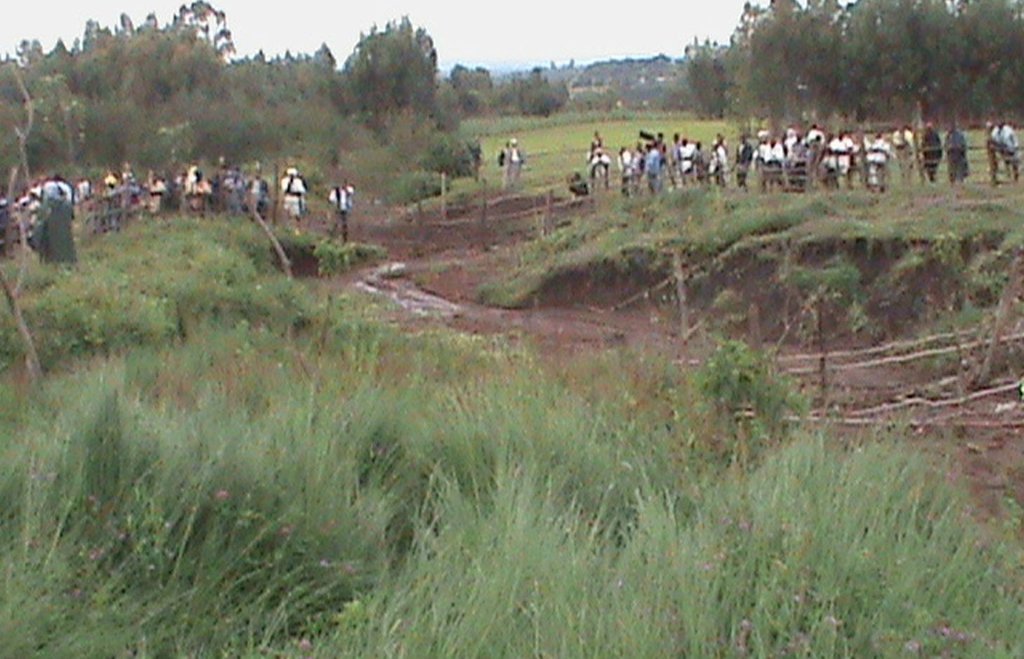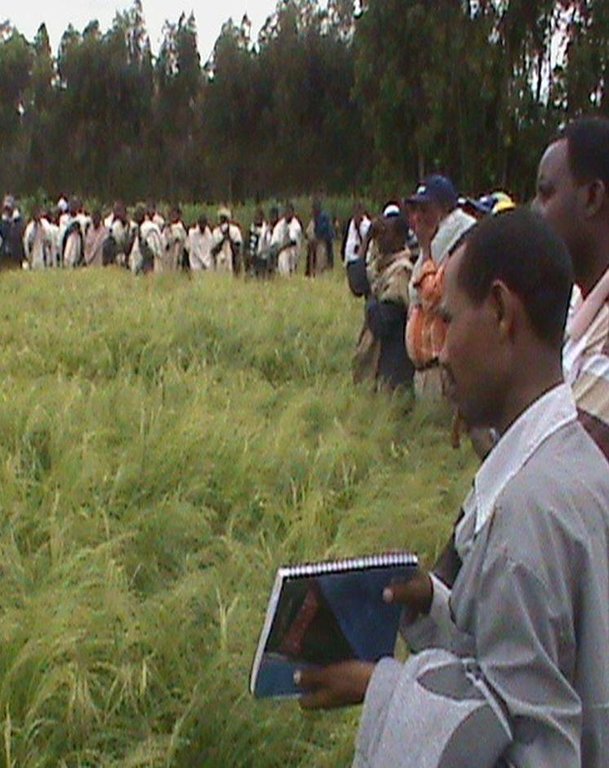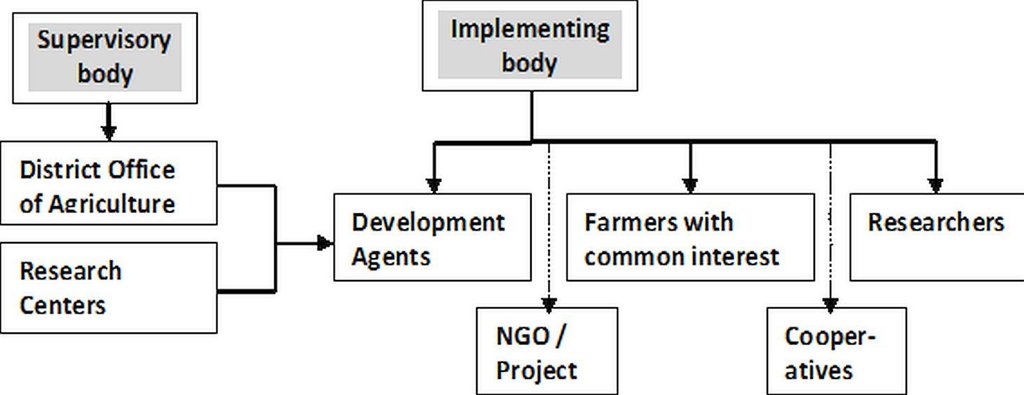Farmer-Research-Extension Group (FREG) [เอธิโอเปีย]
- ผู้สร้างสรรค์:
- การอัพเดท:
- ผู้รวบรวม: Gizaw Desta Gessesse
- ผู้เรียบเรียง: –
- ผู้ตรวจสอบ: Fabian Ottiger
Yearsoader temeramari buden (Amharic)
approaches_2496 - เอธิโอเปีย
ดูส่วนย่อย
ขยายทั้งหมด ย่อทั้งหมด1. ข้อมูลทั่วไป
1.2 รายละเอียดที่ติดต่อได้ของผู้รวบรวมและองค์กรที่เกี่ยวข้องในการประเมินและการจัดเตรียมทำเอกสารของแนวทาง
ชื่อของโครงการซึ่งอำนวยความสะดวกในการทำเอกสารหรือการประเมินแนวทาง (ถ้าเกี่ยวข้อง)
Water and Land Resource Centre (WLRC) - เอธิโอเปีย1.3 เงื่อนไขที่เกี่ยวข้องกับการใช้ข้อมูลที่ได้บันทึกไว้ผ่านทาง WOCAT
วันที่เก็บรวบรวมข้อมูล (ภาคสนาม):
26/05/2014
ผู้รวบรวมและวิทยากรหลักยอมรับเงื่อนไขเกี่ยวกับการใช้ข้อมูลที่ถูกบันทึกผ่านทาง WOCAT:
ใช่
1.4 การอ้างอิงถึงแบบสอบถามเรื่องเทคโนโลยี SLM
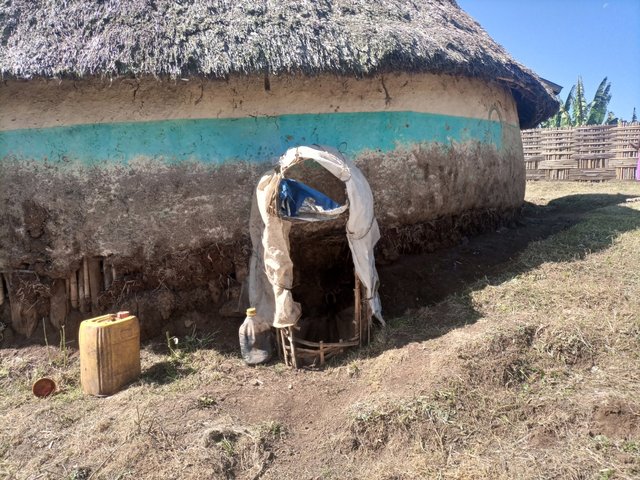
Livestock Urine Collection and Use [เอธิโอเปีย]
Collection of livestock urine allows resource-poor farmers to capture nutrient-rich livestock waste and use it to substitute urea fertilizer. It is a liquid organic product that restores soil fertility and pest management.
- ผู้รวบรวม: GERBA LETA
2. คำอธิบายของแนวทาง SLM
2.1 การอธิบายแบบสั้น ๆ ของแนวทาง
Farmer-Research-Extension Group (FREG) is a grass root level platform aims to bridge gaps on agricultural technology transfer between research and extension linkage and provide a platform of 20-30 members from research, extension and farmer for their joint learning and active participatory role in agricultural technology evaluation and dessimination.
2.2 การอธิบายอย่างละเอียดของแนวทาง
การอธิบายอย่างละเอียดของแนวทาง:
Aims / objectives: FREG aims to facilitate the selection and transfer of agricultural technologies to end users through active participation and coordinated efforts of research-extension and farmer together. The objectives of FREG are: 1) evaluating and selecting improved agricultural technologies through participatory processes at field level, 2) demonstrating improved agricultural technologies to FREG members and other non-member land users in the villages, 3) facilitating farmer to farmer knowledge and technology exchange for faster and wider dissemination and adoption
Methods: In FREG, research takes initiation to facilitate the formation. The group is expected to identify and prioritize problems of their locality on its own and research and extension organizations could take facilitation to form or organize groups based on specific objectives. If the intention is to provide a range of technological options to fit needs and interests of farmers, it can be best developed with participation and through knowledge sharing among stakeholders (research, extension and farmer). Thus, group formation is based on individual and group interests. Those farmers who have similar interests are organized into a group based on proximity including both male and women farmers. Next, the group establish norms, share responsibility, design activity plan, and implement activities. The group meets regularly to evaluate performance of technologies at different stages. During each meeting, it is critical to visit on-farm activities of individual members and assess the relative performance. They develop their own criteria to rank and select the best technologies. Finally, they participate in field days and decide the best technologies for scale up to wider areas.
Stages of implementation: 1. Conduct awareness meeting of farmers about the available technologies for demonstration and scale up and their merits compared to the existing technologies in the hands of farmers.
2. Based on the awareness creation, collect the demands and interests of farmers in which of the technology options they want to involve. Organize into groups according to common interests.
3. Prepare and conduct training about the characteristics of available technologies, procedures of on-farm implementation and evaluation, farmer to farmer technology transfer, and work norms
4. FREG members develop their working norms, decide on the period of meetings, and develop plan of activities
5. Implement on-farm activities and evaluate the performance of planned activities on regular basis
6. Evaluate and rank the technology options based on their own criteria in order to select the best technologies
7. Organize field days to demonstrate and exchange the results of technology options to other non-member farmers and stakeholders. The technologies selected through FREG participatory evaluation procedures need to be supported with research evidences by ARARI.
8. Finally, each member farmer who is involved in on-farm technology evaluation took the responsibility to transfer the selected technology to at least 3-5 other farmers in his locality in order to facilitate quick dissemination, scaling up.
Role of stakeholders: Farmer: The farmers who have common interest on a given technology is responsible to lead the participatory technology selection
Development agents/extension: they should play facilitation and motivation role and help to encourage farmers to become member of FREG. They also follow up whether the FREG accomplish the planned activities and attend regular meetings
Research: research is involved in demonstration of technologies, in the initiation and establishment of FREG and plays a role of facilitation and technology supply. Research need to organize field days and advice other stakeholders to participate in the process
Project/WLRC: Provide material and technical support for the FREG and participate in the meetings and field days
Other stakeholders: The involved actors in the area should actively participate as a FREG member and during field days.
2.3 รูปภาพของแนวทาง
2.5 ประเทศ ภูมิภาค หรือสถานที่ตั้งที่ได้นำแนวทางไปใช้
ประเทศ:
เอธิโอเปีย
ภูมิภาค/รัฐ/จังหวัด: :
Amhara National Regional State
ข้อมูลเฉพาะเพิ่มเติมของสถานที่ตั้ง:
Bahir Dar Zuria, Dembecha, Mecha, Yilmna Densa, Dessie Zuria, Basona Worana
2.6 วันที่เริ่มต้นและสิ้นสุดของแนวทาง
ระบุปีที่เริ่ม:
2005
2.7 ประเภทของแนวทาง
- ใช้โครงงานหรือแผนงานเป็นฐาน
2.8 เป้าหมายหรือวัตถุประสงค์หลักของแนวทาง
The Approach focused mainly on other activities than SLM (Participatory technology evaluation and selection, awareness creation, training, field visits, field days)
The main objective of FREG is to facilitate the participation and involvement of farmers, researchers and extension agents together in technology evaluation, selection and dessimination.
The SLM Approach addressed the following problems: The main problems targeted to address by implementing FREG approach are: low dissemination and adoption of agricultural and natural resource management technologies; linkage gap between research, who generate technologies, and extension who transfer and disseminate technologies; and low participation and involvement of farmers in technology development and selection processes.
2.9 เงื่อนไขที่เอื้ออำนวยหรือเป็นอุปสรรคต่อการนำเทคโนโลยีภายใต้แนวทางนี้ไปปฏิบัติใช้
การมีไว้ให้หรือการเข้าถึงแหล่งการเงินและบริการ
- เป็นอุปสรรค
Low capacity of farmers to afford and use improved technologies
Treatment through the SLM Approach: The approach allows options of in-kind exchange, transfer and dissemination of technologies from farmer to farmer without incurring much cost to them
การจัดตั้งระดับองค์กร
- เป็นอุปสรรค
Inadequate linkage between research and extension that lead to low supply and transfer of technologies
Treatment through the SLM Approach: The FREG is the best link at grass root level where the demand (extension-farmer) and supply (research) can effectively interface
กรอบแนวทางในการดำเนินการด้านกฎหมาย (การถือครองที่ดิน สิทธิในการใช้ที่ดินและน้ำ)
- เป็นอุปสรรค
The existing land ownership, land use rights / water rights hindered a little the approach implementation Since FREG approach is implemented on individual farm plots, entitlement of individual land use right is essential to invest on new agricultural technologies. At same time, water use right has contributed a lot to implement technologies working under irrigated and water harvesting systems. For example, if farmers are not allowed to dig shallow wells and divert streams it was not able to demonstrate and implement home garden in all watersheds and chickpea varieties at Debre Yacob
ความรู้เกี่ยวกับ SLM การเข้าถึงการสนับสนุนด้านเทคนิค
- เป็นอุปสรรค
Lack of information about availability of technologies and inadequate participation of farmers in technology evaluation and selection processes that partly result in low adoption of existing technologies.
Treatment through the SLM Approach: The FREG approach provides choice of technologies for farmers and extension agents and take part in the evaluation and selection of technologies that fit to the system for wider adoption
3. การมีส่วนร่วมและบทบาทของผู้มีส่วนได้ส่วนเสียที่เกี่ยวข้อง
3.1 ผู้มีส่วนได้ส่วนเสียที่เกี่ยวข้องในแนวทางนี้และบทบาท
- ผู้ใช้ที่ดินระดับท้องถิ่นหรือชุมชนระดับท้องถิ่น
Individual land users who have common interest on specific technology
Land users are active members and take the leading responsibility of the process
- ผู้เชี่ยวชาญ SLM หรือที่ปรึกษาการเกษตร
Agricultural specialists and development agents
- นักวิจัย
Researchers has the role to facilitate and provide technologies
- รัฐบาลระดับท้องถิ่น
The development agent together with kebele adminstration, District Agriculture Office Cooperative Agents for implementation and supervision
- รัฐบาลแห่งชาติ (ผู้วางแผน ผู้ทำการตัดสินใจ)
They were involved in the monitoring and evaluation stage
ถ้ามีผู้มีส่วนได้ส่วนเสียหลายคนที่เกี่ยวข้องให้ระบุหน่วยงานตัวแทน:
In FREG, both men and women can be members. Women play a great role in selecting technologies specially technologies related to food processing aspects
3.2 การเกี่ยวข้องของผู้ใช้ที่ดินระดับท้องถิ่นหรือชุมชนระดับท้องถิ่นในช่วงต่างๆของแนวทาง
| ความเกี่ยวข้องของผู้ใช้ที่ดินระดับท้องถิ่นหรือชุมชนระดับท้องถิ่น | ระบุผู้ที่มีส่วนเกี่ยวข้องและอธิบายกิจกรรม | |
|---|---|---|
| การริเริ่มหรือการจูงใจ | ไม่ลงมือ | Land users has no involvement in the initiation of the approach. Land users are part of the process after the planning phase. |
| การวางแผน | ปฏิสัมพันธ์ | At planning stage of the approach, land users' are needed to express their interests and needs of technology options, and their interest to form a group. Land users participate by expressing their technology needs once information about available technology options is provided by the researchers and development agents. |
| การดำเนินการ | ปฏิสัมพันธ์ | Land users are expected beeing actively involved in every stage of the implementation and take the leading responsibility to all activities such as site selection, seed bed preparation, planting, cultivation, harvesting and reporting the productivity. |
| การติดตามตรวจสอบหรือการประเมินผล | ปฏิสัมพันธ์ | Land users are responsible to regularly evaluate the technologies and select the best for promotion and further scale up activities |
| Research | ปฏิสัมพันธ์ | In the FREG approach, participatory technology evaluation and selection is the key element. Thus the land users are allowed to evaluate and select best and suitable ones among several options |
3.3 แผนผังแสดงขั้นตอนการทำงาน (ถ้ามี)
คำอธิบาย:
The district office of agriculture and research centers within ARARI are the supervisory bodies for the implementation of the FREG approach. The main implementer are the member farmers in the group, the researcher and development agent at kebele level. Depending on the availability and interest, NGOs/ Projects and cooperative agents are involved in the implementation of the process.
ผู้เขียน:
Gizaw Desta (WLRC, P.O.Box 8707, Addis Abeba, Ethiopia)
3.4 การตัดสินใจเลือกใช้เทคโนโลยี SLM
ระบุผู้ที่ทำการตัดสินใจเลือกเทคโนโลยีมากกว่าหนึ่งวิธีไปปฏิบัติใช้:
- ผู้ใช้ที่ดินเป็นผู้ตัดสินใจหลัก โดยการสนับสนุนจากผู้เชี่ยวชาญ SLM
การอธิบาย:
Different options of adapted technologies are supplied from research and the farmers can decide and choose the type of technology for demonstration and scale up
Decisions on the method of implementing the SLM Technology were made by mainly by SLM specialists with consultation of land users. Researchers and development agents with active participation of the FREG member farmers decide on the method of implementation
4. การสนับสนุนด้านเทคนิค การสร้างขีดความสามารถ และการจัดการด้านความรู้
4.1 การสร้างขีดความสามารถ / การอบรม
ได้มีการจัดอบรมให้แก่ผู้ใช้ที่ดินหรือผู้มีส่วนได้ส่วนเสียคนอื่น ๆ หรือไม่:
ใช่
ให้ระบุว่าใครเป็นผู้ได้รับการอบรม:
- ผู้ใช้ที่ดิน
- เจ้าหน้าที่ภาคสนาม / ที่ปรึกษา
- Other development agents are involved in cooperatives and other agr. development actions
ถ้าเกี่ยวข้อง ให้ระบุ เพศ อายุ สถานภาพ ชาติพันธุ์ เป็นต้น:
It includes all land users who are members of FREG including women.
รูปแบบการอบรม:
- กำลังดำเนินการ
- เกษตรกรกับเกษตรกร
- ใช้พื้นที่ทำการสาธิต
หัวข้อที่พูด:
Awareness creation and characteristics of the technology, merits of new technologies compared to locally available and adapted technologies, procedures of implementing the technology evaluation and selection, the participation and involvement of FREG members at each stage of the implementation are contents of the training for FREG members before they start implementation.
Development agents and some experts from the district as well as project/NGO offices are contributing to the trainings about the implementation procedures and monitoring and evaluation activities.
4.2 การบริการให้คำแนะนำ
ผู้ใช้ที่ดินมีการเข้าถึงการรับบริการให้คำปรึกษาหรือไม่:
ใช่
ระบุว่ามีบริการให้คำปรึกษาหรือไม่:
- ที่ศูนย์ถาวร
การอธิบาย/แสดงความคิดเห็น:
Name of method used for advisory service: Participatory Demonstration and Training Extension System (PADETES); Key elements: Training and awareness creation of farmers in FTCs , Provision of package of technologies, demonstrations in the Farmer Training Centers (FTC) and experience sharing visits, On job training; The method gives high emphasis to training and to some extent practical demonstrations supported with experience
sharing visits but less emphasis to advisory of farmers on spot
Advisory service is quite adequate to ensure the continuation of land conservation activities; The government service at Kebele level is adequate to ensure the implementation of FREG approach through active involvement of the development agents.
4.3 การเสริมความแข็งแกร่งให้กับสถาบัน (การพัฒนาองค์กร)
สถาบันได้รับการจัดตั้งขึ้นมาหรือเสริมความแข็งแกร่งโดยแนวทางนี้หรือไม่:
- ใช่ ปานกลาง
ระบุระดับของสถาบันที่ได้รับการเสริมความแข็งแกร่งหรือจัดตั้งขึ้นมา:
- ท้องถิ่น
ระบุประเภทของการให้ความช่วยเหลือสนับสนุน:
- การสร้างขีดความสามารถ / การอบรม
ให้รายละเอียดเพิ่มเติม :
Moderate support with awareness creation, training, and supply of some equipments. The local institutions like FREG and Farmer Training Centers (FTCs) are supported by training, and training and demonstration aid facilities
4.4 การติดตามตรวจสอบและประเมินผล
การติดตามตรวจสอบและประเมินผลเป็นส่วนหนึ่งของแนวทางหรือไม่:
ใช่
ความคิดเห็น:
bio-physical aspects were ad hoc monitored by government, land users through observations; indicators: growth performance of varieties or breeds, occurrence of disease and pests
bio-physical aspects were regular monitored by project staff, government through measurements; indicators: amount of inputs applied and labor, production and productivity of comparative technologies by WLRC and ARARI
socio-cultural aspects were regular monitored by project staff, government through measurements; indicators: Change in attitude of technology use, collective action within the group, productivity and economic benefits, exchange of knowledge and technology, transfer and dissemination rate measured jointly by WLRC and ARARI
area treated aspects were ad hoc monitored by project staff, government, land users through observations; indicators: Type of technology, number of users per technology, area covered by the technology
area treated aspects were regular monitored by project staff, government through measurements; indicators: Type of technology and number of users per technology by WLRC
There were several changes in the Approach as a result of monitoring and evaluation: After the monitoring and evaluation, the number of users increase, high demand and request for additional technologies, improved management of the technology were observed.
There were few changes in the Technology as a result of monitoring and evaluation: It sometimes occurs where there are more superior new technologies. For example, Faba Bean varieties were changed by superior one called Wolki variety.
4.5 การวิจัย
การวิจัยเป็นส่วนหนึ่งของแนวทางหรือไม่:
ใช่
ระบุหัวข้อเรื่อง:
- เศรษฐศาสตร์หรือการตลาด
- เทคโนโลยี
ให้ข้อมูลเพิ่มเติมและให้ระบุผู้ทำการวิจัย:
Research play role of initiation of the approach, facilitate the processes, take part in the implementation, monitoring and evaluation, advisory services, supply of the technologies demanded by FREG members, and evaluate the costs and benefits of the demonstrated technologies. The research centers in 2.3.1.1 (i.e., five research centers within the Amhara Region Agricultural Research Institute, ARARI) are fully responsible to conduct demonstrations, pr-extension dissemination of technologies and socio-economic research activities through the FREG
Research was carried out on-farm
5. การสนับสนุนด้านการเงินและวัสดุอุปกรณ์
5.1 ระบุงบประมาณประจำปีสำหรับแนวทาง SLM นี้
ถ้าหากว่างบประมาณประจำปีไม่เป็นที่ทราบแน่นอน ให้ระบุช่วงลงไป:
- 10,000-100,000
แสดงความคิดเห็น (แหล่งของการระดมทุน ผู้บริจาคคนสำคัญ):
Approach costs were met by the following donors: local government (district, county, municipality, village etc) (Research centers (5 research centers within the Amhara Region Agricultural Reserch Institute, ARARI) provide capacity building through training and field visits, and supply of inputs (improved varieties) land allocation, fertilizer, labor): 15.0%; local community / land user(s) (land users contribute fertilizer, labor and allocate land for implementation): 85.0%
5.2 การสนับสนุนด้านการเงิน / วัสดุอุปกรณ์ให้แก่ผู้ใช้ที่ดิน
ผู้ใช้ที่ดินได้รับการสนับสนุนด้านการเงิน / วัสดุอุปกรณ์ไปปฏิบัติใช้เทคโนโลยีหรือไม่:
ใช่
5.3 เงินสนับสนุนสำหรับปัจจัยนำเข้า (รวมถึงแรงงาน)
- การเกษตร
| ระบุปัจจัยนำเข้าที่ได้รับการสนับสนุน | เห็นด้วยระดับไหน | ระบุเงินสนับสนุน |
|---|---|---|
| เมล็ด | ได้รับการช่วยเหลือทางการเงินแบบเต็ม | |
| fruits, tree seedlings, breeds | ได้รับการช่วยเหลือทางการเงินแบบเต็ม | |
ถ้าแรงงานโดยผู้ใช้ที่ดินเป็นปัจจัยนำเข้าที่มีอยู่มากมาย ระบุด้วยว่าเนื่องจาก:
- สมัครใจ
ความคิดเห็น:
Labor to implement on-farm activities is covered by the FREG member or in group voluntarily
5.4 เครดิต
มีการจัดหาเครดิตมาให้ภายใต้แนวทาง SLM หรือไม่:
ใช่
ถ้าใช่ ระบุเงื่อนไข (อัตราดอกเบี้ย การชำระคืน):
Credit is only partly available for specific technology types such as sheep breeds, fattening, potato seed storage and cooperative establishments, apiary
6. การวิเคราะห์ผลกระทบและการสรุป
6.1 ผลกระทบของแนวทาง
ช่วยให้ผู้ใช้ที่ดินนำเอาเทคโนโลยี SLMไปใช้และบำรุงรักษาสภาพไว้ได้หรือไม่:
- ไม่ใช่
- ใช่ เล็กน้อย
- ใช่ ปานกลาง
- ใช่ อย่างมาก
The approach helps to improve sustainable land management indirectly. Farmers who practiced improved technologies increase their productivity per unit area and are thereby capable to purchase more inputs and apply improved sustainable land management technologies. Those who earn high income can afford to invest on sustainable land management.
ทำให้กลุ่มด้อยโอกาสมีอำนาจทางสังคมและเศรษฐกิจหรือไม่:
- ไม่ใช่
- ใช่ เล็กน้อย
- ใช่ ปานกลาง
- ใช่ อย่างมาก
Youth groups who are organized to provide services to farmers by operating and threshing teff and finger millet using introduced threshers gain some benefits. Women FREG households involved in sheep, poultry and energy saving stove production activities got benefit and improved their situation
ปรับปรุงประเด็นของการถือครองที่ดินหรือสิทธิในการใช้ ซึ่งขัดขวางการนำเทคโนโลยีไปใช้ให้ดีขึ้น:
- ไม่ใช่
- ใช่ เล็กน้อย
- ใช่ ปานกลาง
- ใช่ อย่างมาก
The problem is unlikely to be overcome in the near future. The land ownership or land use rights is highly associated with increase in population and then lead to land fragmentation. This implies the need for policy actions on land use rights.
Did other land users / projects adopt the Approach?
- ไม่ใช่
- ใช่ เล็กน้อย
- ใช่ ปานกลาง
- ใช่ อย่างมาก
The approach and/or technology transfer and utilization is gradually expanded to other villages and adjacent watersheds through farmer to farmer technology transfer and share of experiences during field days.
Did the Approach lead to improved livelihoods / human well-being?
- ไม่ใช่
- ใช่ เล็กน้อย
- ใช่ ปานกลาง
- ใช่ อย่างมาก
Using the approach, FREG members and some non-members particularly those who were involved in the production of teff, potato, wheat, barley, and faba bean had improved varieties; in the production of improved breeds of sheep and poultry they hac improved their livelihood situation. Some land users who also produced potato and forage seeds for sale were also benefited. In some watersheds, crop damages by rodent flocks were extremely minimized. FREG members who took part in manual maize sheller and multi-crop thresher technology promotion activities were highly benefited in saving high labor requirement.
Did the Approach help to alleviate poverty?
- ไม่ใช่
- ใช่ เล็กน้อย
- ใช่ ปานกลาง
- ใช่ อย่างมาก
FREG members who were involved in the production of improved agricultural technologies are gradually going to improve their poverty situation.
6.2 แรงจูงใจหลักของผู้ใช้ที่ดินเพื่อที่จะนำ SLM ไปปฏิบัติใช้
- การผลิตที่เพิ่มขึ้น
The immediate interest and objectives of farmers is to increase productivity per unit of their land
- การจ่ายเงินหรือการช่วยเหลือ
Initially some have been motivated by giving them access to improved technologies & inputs
- well-being and livelihoods improvement
They realized that the approache ultimately can improve production, income and livelihood
6.3 ความยั่งยืนของกิจกรรมของแนวทาง
ผู้ใช้ที่ดินสามารถทำให้สิ่งต่างๆ ที่ได้ปฏิบัติใช้โดยแนวทางนี้ยั่งยืนได้หรือไม่ (โดยไม่มีการสนับสนุนจากภายนอก):
- ใช่
ถ้าตอบว่าใช่ ให้อธิบายว่าอย่างไร :
The technologies remain for long in the hands of FREG member farmers. They continue to produce the technology and disseminate in the area through farmer to farmer dissemination system. FREG members acquire capacity to access new technologies from research, extension and input supply seed agencies using the established linkage mechanism. Finally, these ensure sustainability of the approach that aim the transfer and adoption of technologies by farmers
6.4 จุดแข็งและข้อได้เปรียบของแนวทาง
| จุดแข็ง / ข้อได้เปรียบของแนวทางในทัศนคติของผู้ใช้ที่ดิน |
|---|
| Increase the supply of new technologies. (How to sustain/ enhance this strength: Strengthen and expand FREG approach, and the role of research and seed enterprises.) |
| จุดแข็ง / ข้อได้เปรียบของแนวทางในทัศนคติของผู้รวบรวมหรือวิทยากรหลัก |
|---|
| Improves communication and information exchange thereby improving social relations. (How to sustain/ enhance this strength: Can be used as an entry point for social learning a process by which stakeholders in a group learn how to innovate and adopt in response to changing social and environmental conditions.) |
| Increase productivity and efficiency, and empowers farmers economically. (How to sustain/ enhance this strength: Provide variety of technology options every year based on their needs and interests.) |
| It gives an opportunity for the research system to scale up/out shelved technologies and increase the visibility of the research outputs. (How to sustain/ enhance this strength: Encourage research programmes of the research system to use the FREG approach for any technology dissemination and outreach services.) |
| Strengthen the linkage between research and extension at grass root level. (How to sustain/ enhance this strength: Empower the FREG to influence the research agenda and extension system so as to fit to their interests and needs.) |
| Increase the attitude and technical knowledge of land users where to access technologies, and about the merits of improved technologies and their management techniques, and ways of evaluation and selection of technology options. (How to sustain/ enhance this strength: Establish system of equal involvement of members, strong leadership, and supervision system in order to support continuously and empower the FREG.) |
6.5 จุดอ่อน / ข้อเสียเปรียบของแนวทางและวิธีในการแก้ไข
| จุดอ่อน / ข้อเสียเปรียบในทัศนคติของผู้ใช้ที่ดิน | สามารถแก้ไขปัญหาได้อย่างไร |
|---|---|
| Low price of grain as a whole including the improved crop varieties like maize | Undertake market promotion and market linkage activities, and create food menus for home consumption . |
| จุดอ่อน / ข้อเสียเปรียบในทัศนคติของผู้รวบรวมหรือวิทยากรหลัก | สามารถแก้ไขปัญหาได้อย่างไร |
|---|---|
| There is loss of land races by introducing new crop varieties. | Practice systematic conservation of land races and indigenous species. |
| Land users do not maintain the quality of the technology for longer periods. | Develop capacity of land users in maintaining and handling of quality technologies. |
| Lack of access to market for new and improved technologies. | Complement the FREG approach with value chain systems. |
7. การอ้างอิงและการเชื่อมต่อ
7.1 วิธีการหรือแหล่งข้อมูล
- ไปเยี่ยมชมภาคสนาม การสำรวจพื้นที่ภาคสนาม
- การสัมภาษณ์กับผู้ใช้ที่ดิน
ลิงก์และโมดูล
ขยายทั้งหมด ย่อทั้งหมดลิงก์

Livestock Urine Collection and Use [เอธิโอเปีย]
Collection of livestock urine allows resource-poor farmers to capture nutrient-rich livestock waste and use it to substitute urea fertilizer. It is a liquid organic product that restores soil fertility and pest management.
- ผู้รวบรวม: GERBA LETA
โมดูล
ไม่มีโมดูล


